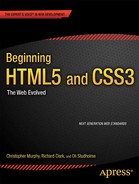Introduction
Who is this book for?
Beginning HTML5 and CSS3: The Web Evolved is aimed at anybody with a basic knowledge of HTML and CSS. If you have just recently dipped your toes into the world of HTML or CSS, or if you’ve been developing sites for years, there will be something in this book for you. However, you will get the most out of this book if you’ve had a play with HTML5 and CSS3 but don’t yet fully understand all it has to offer. This book is packed full of practical, real-world advice and examples to help you master modern web standards.
How is this book structured?
This book is split into two major sections. The first six chapters cover HTML5 and the second seven chapters cover CSS3 complemented by a look to what is coming in the future of Web Standards.
In the first part we will look at where HTML5 came from and how to transition to HTML5 from HTML4. We’ll then show you how to create a HTML5 Boilerplate. This will be followed by introducing new elements, attributes and input types before discussing some of the new, shiny, HTML5 API’s.
In the second part of the book, we’ll learn about the history of CSS and look at some CSS fundamentals. We’ll then introduce new CSS selectors, layout modules and techniques. We then move on to look at web typography, new CSS3 properties and more before guiding you through CSS transitions, transformations and animations.
The book closes with a look at the future of CSS and web standards showing what we’re likely to see in a browser near you in the coming years.
If you want to follow along with the examples in this book, and download any homework files you may require you can do this from http://thewebevolved.com
This book can be read from cover to cover or kept by your computer as a reference of modern tips, tricks, and techniques. The choice is up to you.
Conventions used in this book
This book uses a couple of conventions that are worth noting. The following terms are used throughout this book:
- HTML refers to both the HTML and XHTML languages.
- Unless otherwise stated, CSS relates to the CSS 3 specification.
- Modern browsers are considered to be the latest versions of Firefox, Safari, and Opera along with IE 9 and above.
It is assumed that all the HTML examples in this book are nested in the <body> of a valid document, while the CSS is contained within an external style sheet. Occasionally, HTML and CSS have been placed in the same code example for brevity. However, in a real document, these items need to go in their respective places to function correctly.
p {color: red;}
<p>I’m red</p>
Finally, for HTML examples that contain repeating data, rather than writing out every line, the ellipsis character (. . .) is used to denote code continuation:
<ul>
<li>Red</li>
<li>Yellow</li>
<li>Pink</li>
<li>Green</li>
…
</ul>
With the formalities out of the way, let’s get started.
